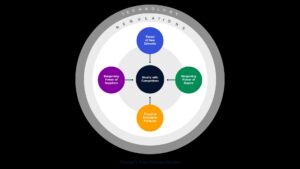The journey to the cloud is accelerating faster than ever, as every industry adapts to a rapidly changing always-on culture. The Banking and Financial Services (BFS) industry is no exception. But as with most complex, modern, global business environments that need to cater to fast-changing requirements, the benefits of the cloud aren’t necessarily a given.
In fact, in a recent study of over 45 banks, The Everest Group found that 70% of BFS enterprises face challenges in realizing the benefits from their cloud transformation journey. Over 88% identify maximizing value acceleration from their cloud investments as a strategic priority.
In this blog, the first part of a three-part series, I’ll outline the challenges faced by BFS organizations as they navigate cloud vendors and best approaches. The second part will get into the dichotomy of cost versus innovation considerations. The final part will discuss how we at Hitachi Digital Services have solved these issues for a large number of customers, and will include actual customer case studies that are using our global, reliable, resilient and cost-optimized Application Reliability Centers today, which incorporate the industry’s best cloud computing services, solutions and frameworks.
Part 1: Changing Priorities for Financial Services Providers
Amidst current global macroeconomic scenarios, banks and financial institutions (FIs) are focused on cutting costs. Many banks and FIs are considering vendor consolidation and looking at strategic suppliers – more discounts, rebates and negotiation power.
Per a recent survey of the market by the Everest Group, large transformation programs are slowing down significantly. Customers look at mandatory growth with sure profitability for limited investments and 100% vendor success when a program is launched to achieve faster Time to Market (TTM). In these circumstances, it becomes imperative for banks and FIs to use their discretionary budgets carefully. Cloud becomes a de facto choice for any big transformation program. But often, once these transformation programs start executing, customers see returns that are not all that promising, and, in some cases, exceed the cost threshold that was planned.
With banking trying to match the cultural preferences of its users with features like real-time payments, embedded finance initiatives, buy now, pay later (BNPL) schemes and more, new ways of authenticating payments have gotten into the mainstream. Any bank that is not innovating enough or partnering with FinTechs in specialized areas will soon find find itself disrupted or amidst a challenging scenario. Banking has become more of an ecosystem play lately, and every player has to be differentiated to attract new customers and find new ways of doing business.
In examining the current banking and financial institutions industry through the lens of famous business strategist and Harvard Business School professor Michael E. Porter’s Five Forces Model, we observe a distinct scenario. The bargaining power of buyers, who are modern customers accustomed to receiving services at any time and place, is notably strong. Conversely, the bargaining power of suppliers, represented by conventional banks’ vendors and suppliers, is weak due to their struggles with broader economic conditions and slender profit margins.

Figure 1: Porter’s Five Forces Model.
“In our post-pandemic world, the top imperative for retail banks has shifted from digital engagement to front-to-back modernization. To succeed, digital innovation must permeate throughout banking operations and modernized core systems to enable new forms of value for end customers. Retail banks will get there with the help of their ecosystem partners.”
-Elena Christopher, Chief Research Officer, HFS
The banking landscape is continually being reshaped by the emergence of FinTechs and NeoBanks, posing a persistent threat to established banks and financial institutions. Innovative solutions like FedNow and RTP in the United States, along with UPI payments in the Asia Pacific region, provide a compelling value proposition from payment service providers, disrupting the conventional payment systems relied upon by traditional banks. Cloud has become a default platform for operations for the banks and FIs. The technology Is evolving frequently, with AI becoming the primary driver for re-imagined products and services.
In response, banks are forming strategic alliances with FinTech companies to reinforce market entry barriers and capitalize on the economies of scale within their reach. Should they manage to withstand the onslaught from NeoBanks and similar innovators, they stand a chance to remain competitive amid shifting market forces. The intensity of the competition is at a peak, further heightened by groundbreaking technological developments and the obsolescence of current risk assessment frameworks. Regulations are becoming more stringent and new regulations for ethical use of AI have started to be implemented in many parts of the world.
Coming up in Part 2, I will discuss the considerations and implications of balancing cloud implementation costs with innovation.
Authors:
Abhishek Bajpayee, Sales Enablement Leader, Technical Sales Organization
Vineeta Kumar, Global Head of Banking, Financial Services and Insurance


